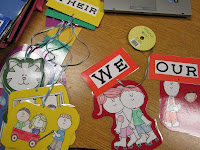Many SLP bloggers and TPT sellers are spending the month of November posting on Facebook about things they are thankful for in their lives. I love the idea of sharing what one is thankful for, but have no intention of filling everyone's facebook timeline with daily posts. It just gets old. So I will post it all in this post and let you read if you want.
1) My parents. They have supported me through thick and thin as I grew up and went to school. They even accepted me back home once I finally graduated so I can save up for a house. (Yes, I know there are tons of articles & news reports about how my generation is freeloading off of parents by moving back home after college. I think somewhere along the line, people have forgotten how different the economy is now in comparison to the way it used to be.)
2) The family pets. Over the summer, I mentioned that we lost two of our pets. It was a very hard time for me as I consider my pets to be people too. You can just look into their eyes and see their innocent souls shining through. I am very thankful for all of the good memories I have with my pets from childhood to the present. I am also glad that we have a new puppy in our lives that brings us much joy (despite the woes of potty training).
3) My excellent co-workers. I think that having good coworkers makes a huge difference in how happy a person is with their job. I am blessed to work with wonderful EC teachers everyday as well as a terrific team of SLPs. It is such a great learning environment.
4) My friends. I don't get to see my friends from college & graduate school very often (if at all). However, I appreciate having those relationships even if the connection stays to facebook messages. Each one is incredible in her or his own right.
5) My pedometer. I'm trying to track how many steps I take a day (working hard towards 10,000 steps) and this little guy makes life so much easier. It's taking a while for me to figure out what I need to do, but I am determined to start losing weight again.
6) Books. Life would not be the same without books and the incredible authors who write them. (Honestly, I would love to write a book.)
7) Education. Life-long learning is the best thing ever.
8) Sweet potatoes.
9) Music. There are few things better than zoning out to a good song.
10) Work. It's nice to make money.
11) Thrift stores. It's nice to save money and still get things that you love.
12) Antique stores. There's just something about seeing items that people used to use all the time that makes me feel so impressed with humanity. Our imaginations can do and make some awesome things. It can also make some scary things too....
13) Movies. It's nice to take a break from reality.
14) Cell phones.
15) Food. Cooking is such a great relaxing thing to do.
16) Internet. It's a great way to connect with SLPs across the globe, learn really cool things, and procrastinate on cleaning.
17) Pinterest. I get so many recipes from this site.
18) Blogging. It's not any easy thing to do, but I've really enjoyed having the ability to see how much I've grown as an SLP.
19) Sharpies. They are a staple in my speech room.
20) ABC & the CW. These two networks got me through graduate school in one piece.
21) Sandals. I could wear them every day for the rest of my life.
22) Jewelry.
23) Chapstick. Appalachian really made me value the importance of avoiding wind-burn.
24) Sweet tea.
25) Nature. There are so many beautiful things around us every day.
26) Animals of all kinds.
27) Our veterans and soldiers. They sacrifice so much to keep us safe.
28) Health.
29) Medicine.
30) Life. It's something so precious, but often taken for granted.



































